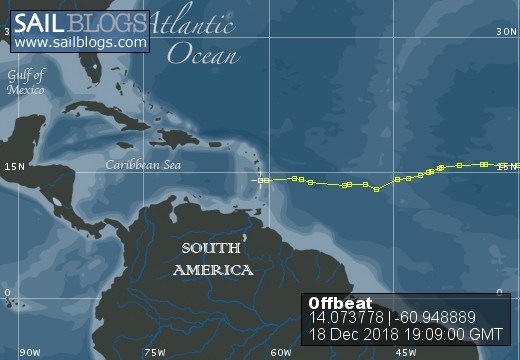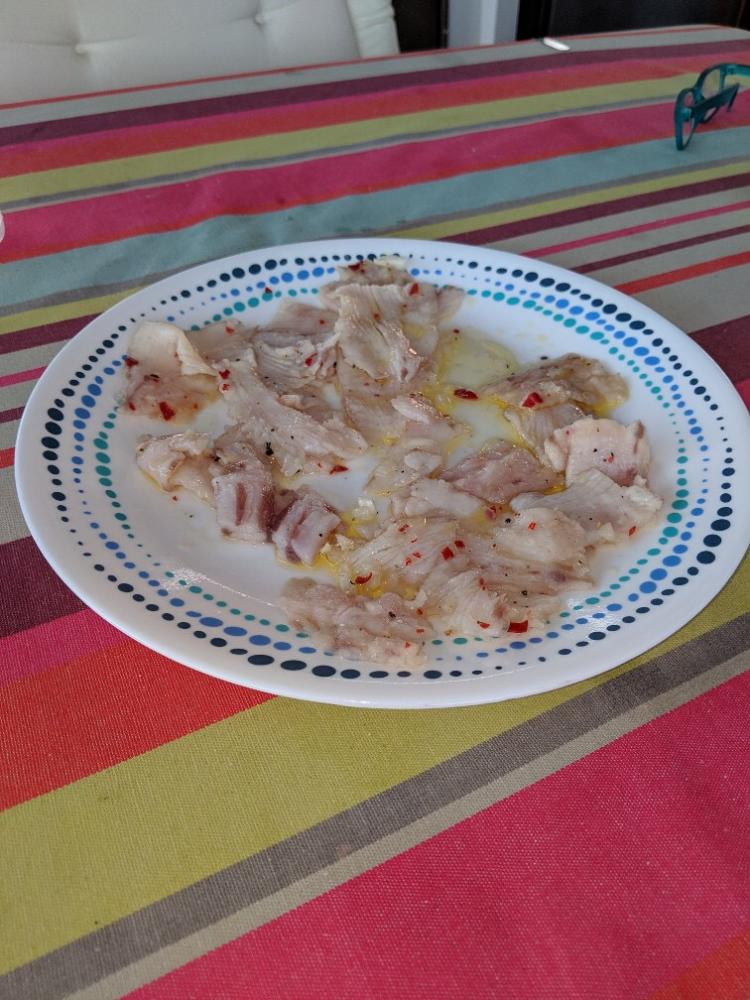

Sailing Offbeat (2016-2018)
Offbeat in ARC+ Cape Verdes 2018. For our current adventures and new boat see www.sailingoffbeat.com
21 October 2023
18 December 2018
03 December 2018
02 December 2018
29 November 2018
28 November 2018
26 November 2018
23 November 2018
20 November 2018
15 November 2018
13 November 2018
11 November 2018
11 November 2018 | Las Palmas, Gran Canaria
06 October 2018
04 October 2018
01 October 2018
29 September 2018
28 September 2018
26 September 2018
25 September 2018
Keep up to date with our latest adventure at sailingoffbeat.com
21 October 2023
David McLeman
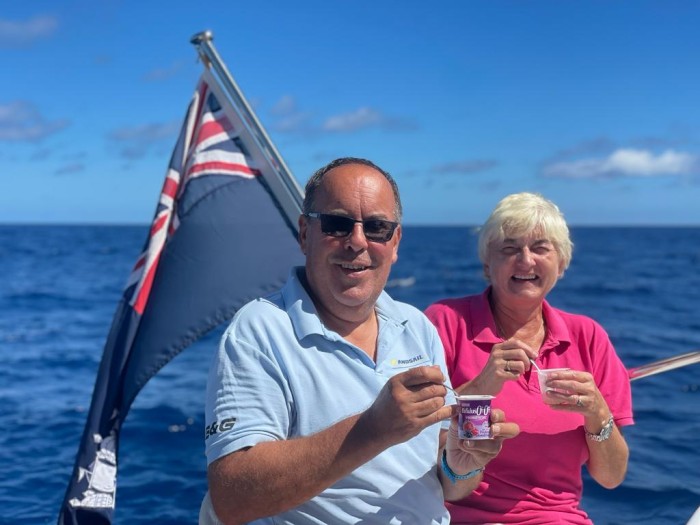
Atlantic crossing? Box ticked!
18 December 2018
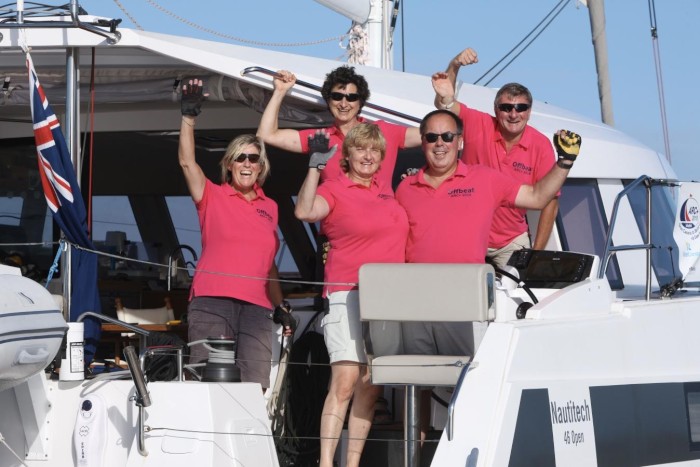
It's now some two weeks since we arrived in St Lucia, apologies for the delay in the last post.
The last day at sea was as breezy as the previous night and we were only 15 miles from Saint Lucia when we were hit by the biggest squall of the whole crossing. 2 reefs quickly in the main, 1/2 rolled jib, then rain and 38kts of wind. Offbeat handled it perfectly and we set another speed record of 21kts as I took off the auto-pilot and steered her down the face of a large wave. 20 mins later we are wallowing in 12 kts of wind.
After having lunch, we rehoisted the Code 0 for the final few miles to Pigeon Island and then rounded up for the short beat to the finish. We were all elated to cross the line and only sorry we couldn't live stream the arrival for you (mobile data is 3G at best and very expensive).
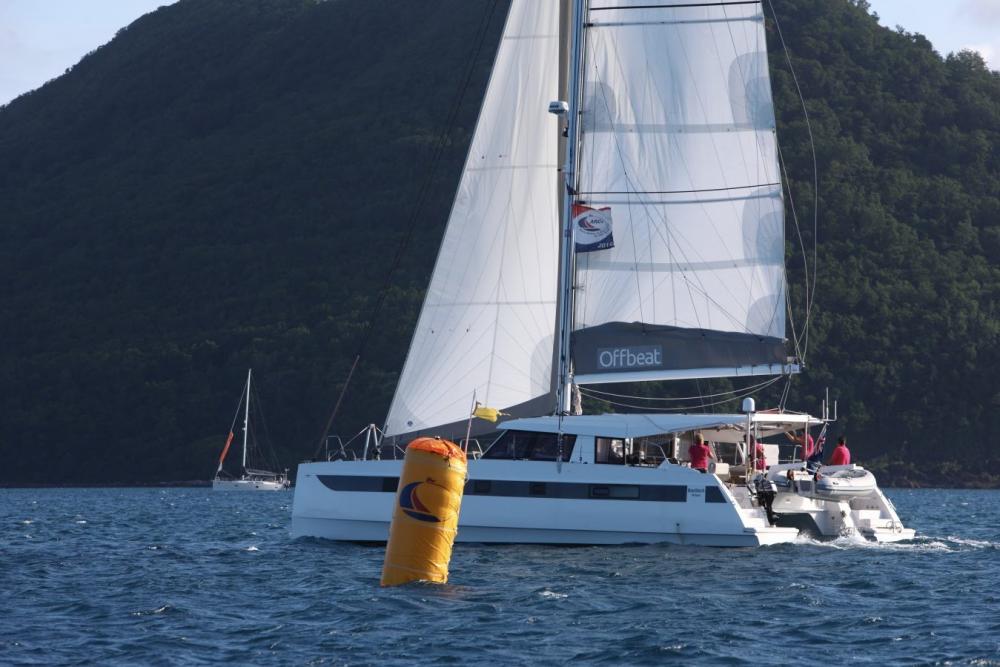
(photos taken by Tim Wright from PhotoAction http://www.photoaction.com/arc18/arc18.htm)
30 minutes later we were moored on a pontoon at Rodney Bar Marina, the ARC "Yellow shirts" were there to greet us with a bowl of fresh fruit and 5 rum punches. We went ashore to complete the marina and customs formalities and then bumped into the crew of Porto Salgado, the Irish boat we'd had to avoid in mid-Atlantic . They had set up the "Irish embassy" in one of the bars and unfortunately, once detained, we didn't get released for about 4 hours!
Over the next couple of days we started to wind down, 12 days and nights offshore sailing leaves the body clock disrupted and you are never completely relaxed. We checked the boat again and took short sails up and down Saint Lucia with overnight stays at Marigot Bay; on a mooring off Soufriere where we had a wonderful display by large fish eating bats; and at anchor out in Rodney Bay again.
Reflecting on the trip; we had prepared well, both the boat and as a crew, and that gave us an easier and faster trip than some of the other boats. It certainly had moments of drama; sails dropping into the water, reefing in the middle of the night and trips up the mast. We tested our ingenuity making running repairs to the boat (I'm not known for my handyman skills) and Lucy was a star with her rigging skills (whether repairing halliards, sails or making yet another block with a low-friction rings and dyneema). The strength of sailing experience with Mike, Sarah and Lucy meant that we were always were well within the capabilities of the crew. Our first-class catering, the ability to have near limitless fresh water from our watermaker and sailing flat on a catamaran also made life much more comfortable than for most of the mono-hull fleet.
Good satellite communications on board also helped; I could stay in touch with the business but I'm really grateful to Dave, Trevor and Vicky that the conversations and emails reduced to a trickle as the trickle as the trip went on - do you really need us back?? (don't answer that!). We could also make calls to stay in touch with anxious parents which was particularly important when Lucy's mum fell ill just after we'd left Cape Verde; we were all so relieved when she was discharged from hospital. The comms also helped with this blog and we really all loved the feedback from all of you, our supporters in comments, facebook "likes" and emails.
The final party and prizegiving was held on the Wednesday evening, we spent a fair bit of time with Rolf's team on Skyfall who had deservedly won the Multihull class, they'd pushed really hard to beat us and had little or none of the sail problems which had hampered us at the start of the leg.
The evening was another great opportunity to meet with the many of the other crews we had got to know well but, as we all swapped contact details, we soon realised it wasn't really goodbye as many of the boats were going to be cruising in the nearby islands with us until Christmas.
On a few boats we'd seen some people jump ship the moment they hit dry land; some boats had very different expectations amongst the crew, personality conflicts or those who were crippled by seasickness (or anxiety?). I think for most of us it was the longest period of time we've ever spent with other people in such close proximity (nearly six weeks on board together since Las Palmas), so I'm delighted the crew of Offbeat kept in good humour during the whole shared adventure and we were in the vast majority of boats for whom it was a massively positive experience; testing but enjoyable.
I think after that length of time though we were all missing family and the following afternoon it was time to drive Mike, Sarah and Lucy to the airport (an interesting drive on a National Holiday in St Lucia!). We've taken the other approach and our children arrive in St Lucia this afternoon to spend Christmas on the boat with us before we all fly back in the New Year.
Time to shut down the blog for now but thanks again to all of you for your support.
The last day at sea was as breezy as the previous night and we were only 15 miles from Saint Lucia when we were hit by the biggest squall of the whole crossing. 2 reefs quickly in the main, 1/2 rolled jib, then rain and 38kts of wind. Offbeat handled it perfectly and we set another speed record of 21kts as I took off the auto-pilot and steered her down the face of a large wave. 20 mins later we are wallowing in 12 kts of wind.
After having lunch, we rehoisted the Code 0 for the final few miles to Pigeon Island and then rounded up for the short beat to the finish. We were all elated to cross the line and only sorry we couldn't live stream the arrival for you (mobile data is 3G at best and very expensive).

(photos taken by Tim Wright from PhotoAction http://www.photoaction.com/arc18/arc18.htm)
30 minutes later we were moored on a pontoon at Rodney Bar Marina, the ARC "Yellow shirts" were there to greet us with a bowl of fresh fruit and 5 rum punches. We went ashore to complete the marina and customs formalities and then bumped into the crew of Porto Salgado, the Irish boat we'd had to avoid in mid-Atlantic . They had set up the "Irish embassy" in one of the bars and unfortunately, once detained, we didn't get released for about 4 hours!
Over the next couple of days we started to wind down, 12 days and nights offshore sailing leaves the body clock disrupted and you are never completely relaxed. We checked the boat again and took short sails up and down Saint Lucia with overnight stays at Marigot Bay; on a mooring off Soufriere where we had a wonderful display by large fish eating bats; and at anchor out in Rodney Bay again.
Reflecting on the trip; we had prepared well, both the boat and as a crew, and that gave us an easier and faster trip than some of the other boats. It certainly had moments of drama; sails dropping into the water, reefing in the middle of the night and trips up the mast. We tested our ingenuity making running repairs to the boat (I'm not known for my handyman skills) and Lucy was a star with her rigging skills (whether repairing halliards, sails or making yet another block with a low-friction rings and dyneema). The strength of sailing experience with Mike, Sarah and Lucy meant that we were always were well within the capabilities of the crew. Our first-class catering, the ability to have near limitless fresh water from our watermaker and sailing flat on a catamaran also made life much more comfortable than for most of the mono-hull fleet.
Good satellite communications on board also helped; I could stay in touch with the business but I'm really grateful to Dave, Trevor and Vicky that the conversations and emails reduced to a trickle as the trickle as the trip went on - do you really need us back?? (don't answer that!). We could also make calls to stay in touch with anxious parents which was particularly important when Lucy's mum fell ill just after we'd left Cape Verde; we were all so relieved when she was discharged from hospital. The comms also helped with this blog and we really all loved the feedback from all of you, our supporters in comments, facebook "likes" and emails.
The final party and prizegiving was held on the Wednesday evening, we spent a fair bit of time with Rolf's team on Skyfall who had deservedly won the Multihull class, they'd pushed really hard to beat us and had little or none of the sail problems which had hampered us at the start of the leg.
The evening was another great opportunity to meet with the many of the other crews we had got to know well but, as we all swapped contact details, we soon realised it wasn't really goodbye as many of the boats were going to be cruising in the nearby islands with us until Christmas.
On a few boats we'd seen some people jump ship the moment they hit dry land; some boats had very different expectations amongst the crew, personality conflicts or those who were crippled by seasickness (or anxiety?). I think for most of us it was the longest period of time we've ever spent with other people in such close proximity (nearly six weeks on board together since Las Palmas), so I'm delighted the crew of Offbeat kept in good humour during the whole shared adventure and we were in the vast majority of boats for whom it was a massively positive experience; testing but enjoyable.
I think after that length of time though we were all missing family and the following afternoon it was time to drive Mike, Sarah and Lucy to the airport (an interesting drive on a National Holiday in St Lucia!). We've taken the other approach and our children arrive in St Lucia this afternoon to spend Christmas on the boat with us before we all fly back in the New Year.
Time to shut down the blog for now but thanks again to all of you for your support.
A squally last night at sea...
03 December 2018
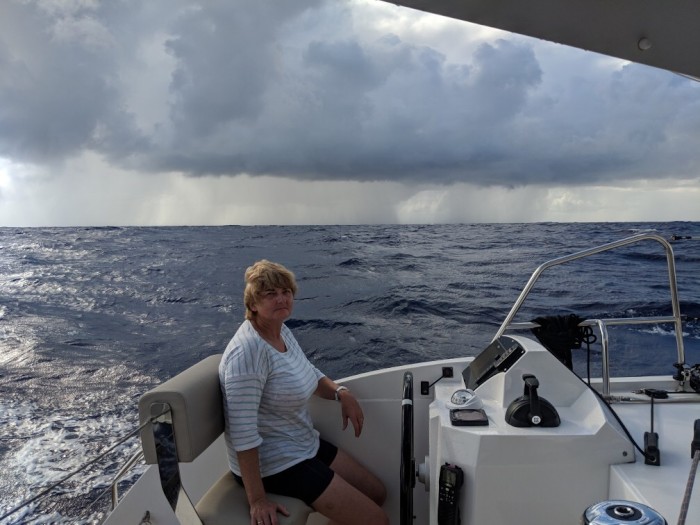
As we approach St Lucia the passage has given us a last reminder of ocean sailing. Approaching the islands overnight the clouds have built up. At around midnight local (4am UK) we saw two large squalls approaching separated by about 4 miles. It looked as if we'd pass between them but being prudent we decided to furl and drop the downwind sail and let them ride over us on jib alone.
Our well polished routine kicked in action, Mike and Lucy handling the foredeck (very large and safe with the wide trampoline), Anne-Laure halfway down the deck helping with the halyards and relaying messages, Sarah and myself in the cockpit on the sheets, halyards and steering. Everyone clipped on, wearing lifejackets and secure.
First we turn the deck lights on so we can see what we are doing and watch out for each other (the short term loss of night vision isn't a priority); jib rolled out to provide a lee (take the wind out) for the downwind sail; furl twizzle (downwind sail); drop the twizzle onto the deck; get soaking wet as the squall hits us as we are tidying up (salt water on shorts and underwear for Mike and Lucy from waves splashing through the trampoline, fresh rain water on shirts for all of us) and reconvene in the cockpit to pat ourselves on the back for a manoeuvre safely accomplished.
It turned out to be a good call as the squall had over 30 kts of wind, not extreme but better safe than sorry (40-50 kts is possible). The squall passed through in only 15 minutes and then we reversed the whole operation and were back to twizzle and 8kts boat speed again some 45 minutes later.
This is where some of the more hard core boats have gained distance by keeping their spinnakers up at all times. We had a email from one of the other front boats who'd kept pressing the whole time, even in the 30kts on days 2, 3 and 4 but they had blown out one spinnaker and then broke their boom in a gybe! We, however, are on a ra, ra, ra....(you know the rest!).
In daylight it's easy to see the squalls visually, and sometimes at night but harder, however if they are raining we can see them clearly on the radar, which we can overlay on our electronic chart plotter.
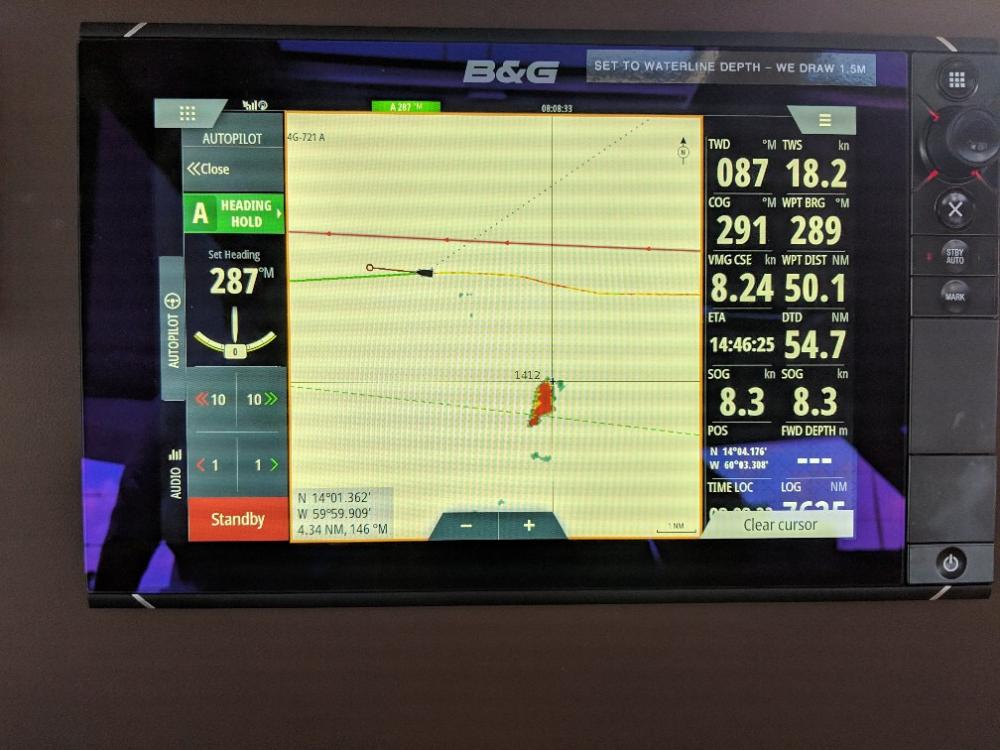
The black boat in the image is Offbeat, the red and orange blob is the squall about 3 miles away, and the photo at the top is the squall itself passing by on our port side; taken only 10 minutes after the radar image, this squall had already dropped most of its rain, earlier you couldn't see the horizon beneath the cloud.
Keeping a good watch for squalls sometimes means that, if we spot them early enough, we can alter course to avoid them entirely or at least avoid the worst of them. It's now 0900 and we are dodging one about every 30 minutes. We hope it starts to clear up as the day warms up.
We are all delighted to have finished our last night watches and are looking forward to a quiet stable bunk in the marina tonight.
We've now only got 48 miles to the finish line, which we expect to cross between 1400 and 1500 local time (1800-1900 UK). Watch out for a live stream on the Facebook page if we can.
Our well polished routine kicked in action, Mike and Lucy handling the foredeck (very large and safe with the wide trampoline), Anne-Laure halfway down the deck helping with the halyards and relaying messages, Sarah and myself in the cockpit on the sheets, halyards and steering. Everyone clipped on, wearing lifejackets and secure.
First we turn the deck lights on so we can see what we are doing and watch out for each other (the short term loss of night vision isn't a priority); jib rolled out to provide a lee (take the wind out) for the downwind sail; furl twizzle (downwind sail); drop the twizzle onto the deck; get soaking wet as the squall hits us as we are tidying up (salt water on shorts and underwear for Mike and Lucy from waves splashing through the trampoline, fresh rain water on shirts for all of us) and reconvene in the cockpit to pat ourselves on the back for a manoeuvre safely accomplished.
It turned out to be a good call as the squall had over 30 kts of wind, not extreme but better safe than sorry (40-50 kts is possible). The squall passed through in only 15 minutes and then we reversed the whole operation and were back to twizzle and 8kts boat speed again some 45 minutes later.
This is where some of the more hard core boats have gained distance by keeping their spinnakers up at all times. We had a email from one of the other front boats who'd kept pressing the whole time, even in the 30kts on days 2, 3 and 4 but they had blown out one spinnaker and then broke their boom in a gybe! We, however, are on a ra, ra, ra....(you know the rest!).
In daylight it's easy to see the squalls visually, and sometimes at night but harder, however if they are raining we can see them clearly on the radar, which we can overlay on our electronic chart plotter.

The black boat in the image is Offbeat, the red and orange blob is the squall about 3 miles away, and the photo at the top is the squall itself passing by on our port side; taken only 10 minutes after the radar image, this squall had already dropped most of its rain, earlier you couldn't see the horizon beneath the cloud.
Keeping a good watch for squalls sometimes means that, if we spot them early enough, we can alter course to avoid them entirely or at least avoid the worst of them. It's now 0900 and we are dodging one about every 30 minutes. We hope it starts to clear up as the day warms up.
We are all delighted to have finished our last night watches and are looking forward to a quiet stable bunk in the marina tonight.
We've now only got 48 miles to the finish line, which we expect to cross between 1400 and 1500 local time (1800-1900 UK). Watch out for a live stream on the Facebook page if we can.
Weed and a candlelit dinner at sea...
02 December 2018
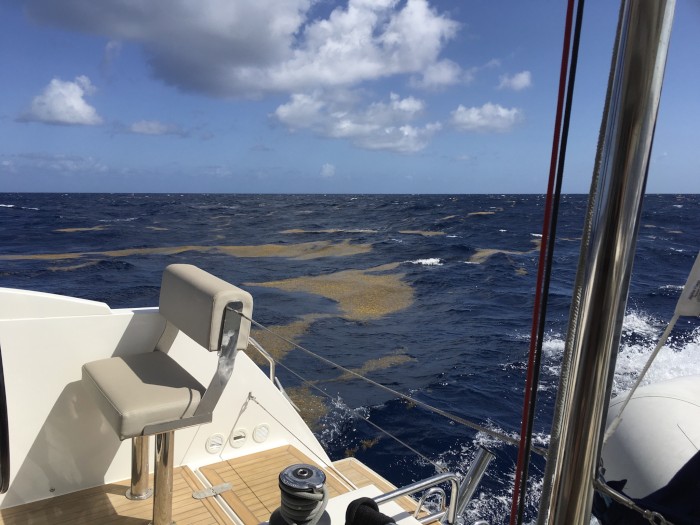
Our blog, about the sounds at sea, clearly caught your imagination from the number of messages we've had, so we've uploaded a short video to let you listen in. Apologies for the very highly compressed video quality necessitated by our satellite link. Yesterday afternoon had very moderate conditions, so very few "bangs", but if you turn the sound up you'll get an idea. Multiple by 3 for the rough conditions we had at the beginning of the leg and then close your eyes and add in the anxiety factor at night when it always seems as if the boat is going faster than it actually is.......
It feels as if we are now in the final stretch, it's 0200 at the moment on Sunday morning, we have just under 300 miles to go and the first boat (Nika, a beautiful £2m+ sixty-five foot performance monohull) has crossed the line a little earlier this evening. We should finish on Monday, it looks as if we'll be second multihull to cross the line (although the first cat motored a lot on the first day they have sailed very well). It's a shame we had so many sail problems earlier in the week, these probably cost us around 60 miles...but it's a rally!
Today we had chafe in our spinnaker halliard again, it took about an hour to sort out and we've run out of rope to shorten it. If it goes again, we've run out of options and will finish on main and jib only. Next time (!) we'll have to find a way to have two spinnaker halliards. We've now got a small list of potential improvements for the boat, even though we were well prepared.
We are looking forward to our first rum punch ashore but I doubt we'll be able to eat much better than in our restaurant on board. On Friday we realised we were seeing increased amounts of Sargasso weed in the sea; we are very much on the southern extreme of the Sargasso Sea, it's centre is several hundred miles north of us and is a gyre, surrounded by four ocean currents spinning clockwise including the Gulf Stream to the east and the Northern Equatorial Current, which we are riding, to the south. In this region this very important weed grows and forms streaks and clumps in the water. Although it's seen as a problem when it hits tourist beaches (and more is forming as the seas heat up through global warming), it's vital for sea life providing protection for young fish, eels and turtles. (Thanks to Sarah for the research!).
As we passed through some patches of weed we suddenly realised that it might be a chance for our fishing to improve. We've had lines out each time the weather moderated,; we hooked a large fish on Thursday but lost it; our line broke and we lost a lure again on Friday afternoon. This time however I was letting out the line out, about 80 metres behind the boat, when I saw a streak of foam rush across, leap out of the water and take the lure. Less than 3 minutes and we'd hooked a fish, brilliant(!), except we were sailing at 9kts and the drag was crazy.
The line ran out at speed and it was all hands on deck. Fortunately our squall practice has helped and, after about 5 minutes, Mike, Lucy, Sarah and Anne-Laure had managed to furl the code zero to slow the boat whilst I hung onto the fish. 20 minutes later we'd landed a small 3kg Mahi-Mahi, which we'd dispatched humanely and quickly and had been filleted on the back of the boat. Change of plans for dinner!
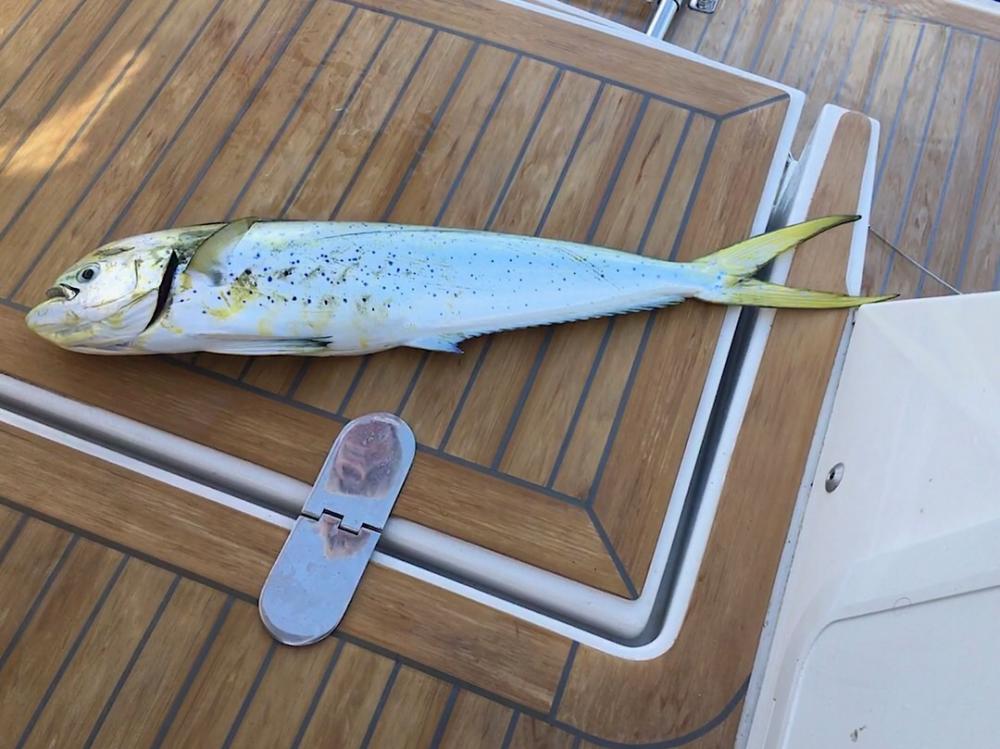
We decided to make Friday night special, we were romping along in a slight to moderate sea, the sun was setting; time to lay the table and bring out candles. The menu? Ceviche for starters (Mahi-Mahi strips marinated in lime juice and chillies) with a single, very light, G&T (Sarah under careful supervision!) followed by the Mahi-Mahi fillets with crudités and roasted new potatoes, accompanied by a nice bottle of white wine. Ok so we confess, it's not difficult out here all of the time!!
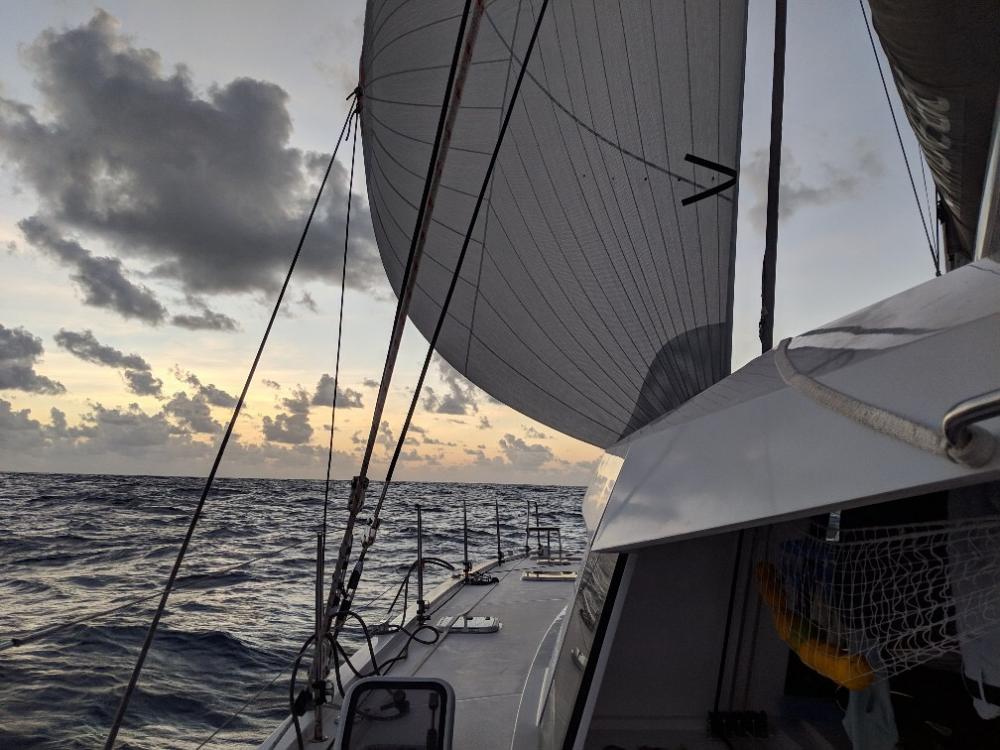

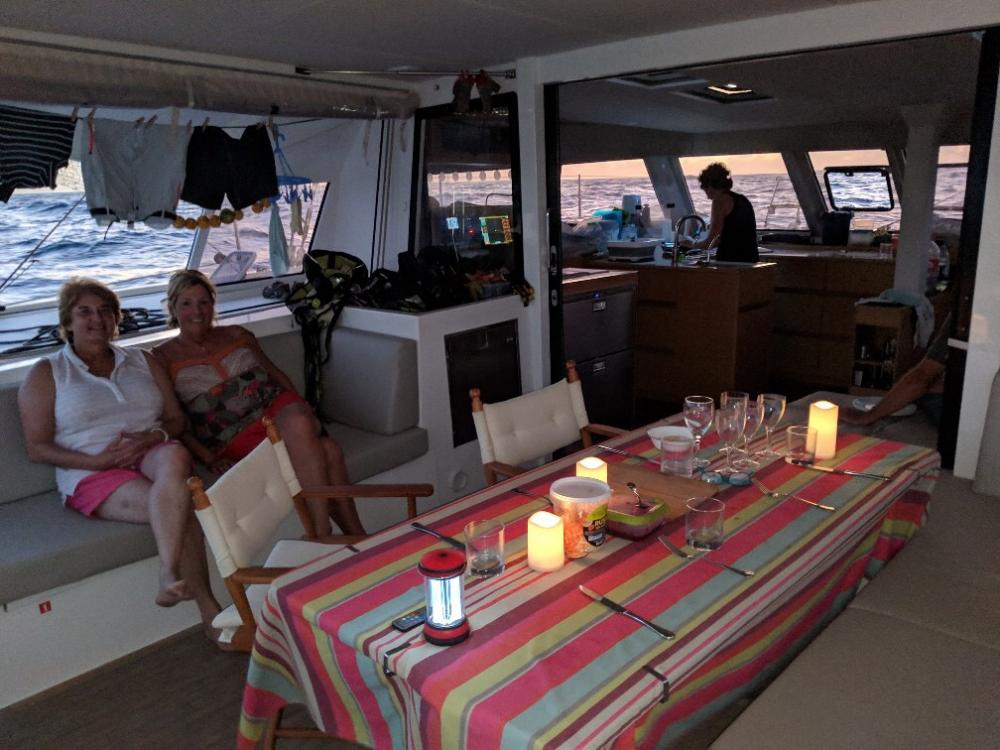
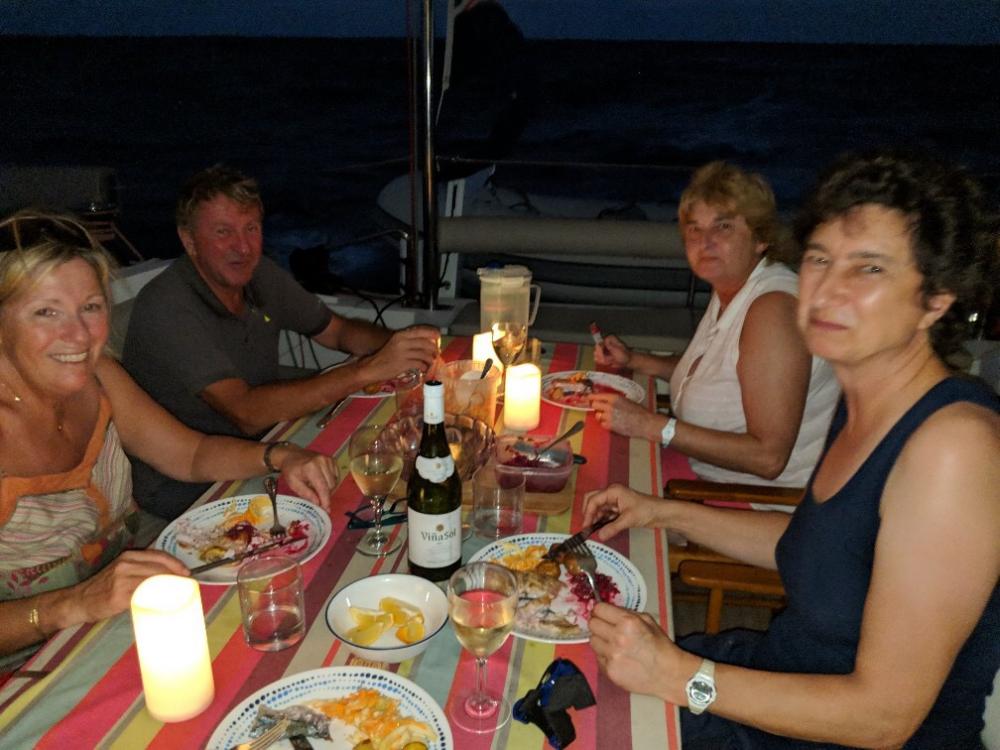
It feels as if we are now in the final stretch, it's 0200 at the moment on Sunday morning, we have just under 300 miles to go and the first boat (Nika, a beautiful £2m+ sixty-five foot performance monohull) has crossed the line a little earlier this evening. We should finish on Monday, it looks as if we'll be second multihull to cross the line (although the first cat motored a lot on the first day they have sailed very well). It's a shame we had so many sail problems earlier in the week, these probably cost us around 60 miles...but it's a rally!
Today we had chafe in our spinnaker halliard again, it took about an hour to sort out and we've run out of rope to shorten it. If it goes again, we've run out of options and will finish on main and jib only. Next time (!) we'll have to find a way to have two spinnaker halliards. We've now got a small list of potential improvements for the boat, even though we were well prepared.
We are looking forward to our first rum punch ashore but I doubt we'll be able to eat much better than in our restaurant on board. On Friday we realised we were seeing increased amounts of Sargasso weed in the sea; we are very much on the southern extreme of the Sargasso Sea, it's centre is several hundred miles north of us and is a gyre, surrounded by four ocean currents spinning clockwise including the Gulf Stream to the east and the Northern Equatorial Current, which we are riding, to the south. In this region this very important weed grows and forms streaks and clumps in the water. Although it's seen as a problem when it hits tourist beaches (and more is forming as the seas heat up through global warming), it's vital for sea life providing protection for young fish, eels and turtles. (Thanks to Sarah for the research!).
As we passed through some patches of weed we suddenly realised that it might be a chance for our fishing to improve. We've had lines out each time the weather moderated,; we hooked a large fish on Thursday but lost it; our line broke and we lost a lure again on Friday afternoon. This time however I was letting out the line out, about 80 metres behind the boat, when I saw a streak of foam rush across, leap out of the water and take the lure. Less than 3 minutes and we'd hooked a fish, brilliant(!), except we were sailing at 9kts and the drag was crazy.
The line ran out at speed and it was all hands on deck. Fortunately our squall practice has helped and, after about 5 minutes, Mike, Lucy, Sarah and Anne-Laure had managed to furl the code zero to slow the boat whilst I hung onto the fish. 20 minutes later we'd landed a small 3kg Mahi-Mahi, which we'd dispatched humanely and quickly and had been filleted on the back of the boat. Change of plans for dinner!

We decided to make Friday night special, we were romping along in a slight to moderate sea, the sun was setting; time to lay the table and bring out candles. The menu? Ceviche for starters (Mahi-Mahi strips marinated in lime juice and chillies) with a single, very light, G&T (Sarah under careful supervision!) followed by the Mahi-Mahi fillets with crudités and roasted new potatoes, accompanied by a nice bottle of white wine. Ok so we confess, it's not difficult out here all of the time!!




Night sailing mind games
29 November 2018
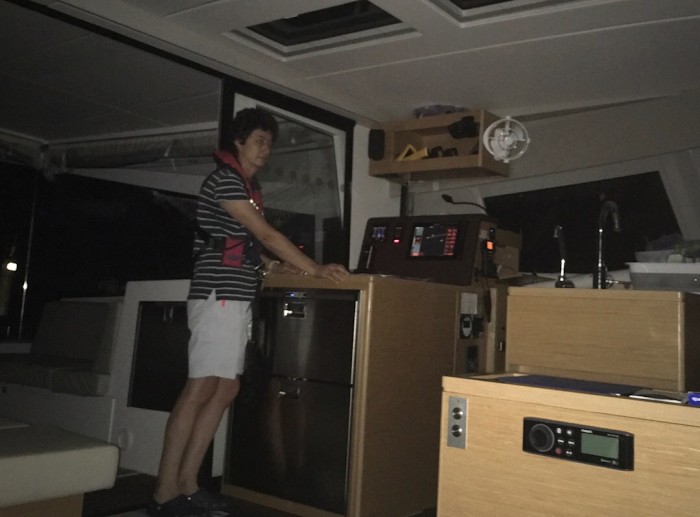
It's dawn on Thursday, another 12 hours of night sailing behind us, and, for almost the first time, one that's been uninterrupted by sail changes, course changes or equipment failures.
Strangely this doesn't mean that sleep has been any less disturbed, night sailing plays tricks with the mind, especially when sailing fast downwind.
We've actually had the steadiest weather conditions of the whole rally, 18/19 knots all night, occasionally increasing to 22kts and sometimes dropping to 16. We've been sailing at an average of 8-9kts boat speed all night (the tracker will show slightly less as we aren't going directly to St Lucia and the speed shown is the component in that direction).
Offbeat revels in these conditions, stable and fast. However the boat is full of noises which play havoc with your perception of the environment, especially on a Nautitech catamaran which has an enclosed saloon, which is great for shelter and security and does provide 360 degree views.
There are three sort of noises onboard; whooshes, bangs and creaks. If you are in the cabins the sound can be very loud, and, as you can't actually see the waves, the sky or the "numbers" (wind speed, boat speed, wind angle), your mind guesses, usually inaccurately, what's happening based on the cacophony of sound.
Everyone on board, me included, has when "off watch", come up to the saloon to find out when or whether we are going to slow the boat down or put a reef in only to discover that sometimes the wind as actually decreased but it's just the noises have changed.
Whooshes are the sound of the water rushing past the hull, as the boat surfs down the face of the wave, in the cabins you can hear an express train of bubbles rushing under the hull as the boat speed increases up to 13 kts before slowing again at the bottom of the wave.
Bangs are when waves hit the hull, as we are nearly directly going downwind these are from waves catching the boat up from behind. Most just lift the stern and gently lower it again but the waves aren't in neat lines, the diagonal ones come between the hulls and smack into the side with a violent jolt, right next to your pillow when sleeping in the rear cabins. Ironically the slower the boat goes the more "bangs" we get. Tonight we've been sailing fast, nearly the same speed as the waves, so few are hitting the boat...hence the visits from the off watch crew (me included!) when the wind is actually lighter.
Finally there are the creaks. There are two varieties: woodwork creaks as the hull moves and the interior walls and furniture rub against each other, each cabin has its own selection of these which you quickly come to recognise. The other variety come from the rig created by the loads of the sails, mast, halliard and sheets. All boat owners listen carefully to these, a change can indicate a potential problem. Tonight though it's been the same sound throughout, a creaking as the spinnaker halliard stretches about 1 cm on each wave, absorbing some of the load on the rig.
Our watch duties are to check the "numbers". Is the wind increasing or decreasing, do we need to change anything, maybe tweak the course by pressing the autopilot buttons or adjust the sails and we need look for ships and other yachts, visually for lights but mostly using the AIS on the chartplotters. Mostly it's just watching, the autopilot does all the steering.
Interestingly each of us on board have found favourite places to do their watch. I tend to sit in the cockpit seats outside the saloon, fresh air but close to the saloon, getting up every 15 minutes or so to look inside and around the horizon; Mike and Sarah, who are doing a slightly longer watch together seem to sit on the seats just inside and outside the saloon doorway able to watch the chartplotter directly; Lucy stays on her feet, mostly by the nav station, but I think Anne-Laure got it right last night, she sat outside clipped on at the helm station away from most of the upsetting "noises" inside, a clear view of the sails, enjoying the wind in her hair, the view of the stars above, and the sound of the waves by her side.
Strangely this doesn't mean that sleep has been any less disturbed, night sailing plays tricks with the mind, especially when sailing fast downwind.
We've actually had the steadiest weather conditions of the whole rally, 18/19 knots all night, occasionally increasing to 22kts and sometimes dropping to 16. We've been sailing at an average of 8-9kts boat speed all night (the tracker will show slightly less as we aren't going directly to St Lucia and the speed shown is the component in that direction).
Offbeat revels in these conditions, stable and fast. However the boat is full of noises which play havoc with your perception of the environment, especially on a Nautitech catamaran which has an enclosed saloon, which is great for shelter and security and does provide 360 degree views.
There are three sort of noises onboard; whooshes, bangs and creaks. If you are in the cabins the sound can be very loud, and, as you can't actually see the waves, the sky or the "numbers" (wind speed, boat speed, wind angle), your mind guesses, usually inaccurately, what's happening based on the cacophony of sound.
Everyone on board, me included, has when "off watch", come up to the saloon to find out when or whether we are going to slow the boat down or put a reef in only to discover that sometimes the wind as actually decreased but it's just the noises have changed.
Whooshes are the sound of the water rushing past the hull, as the boat surfs down the face of the wave, in the cabins you can hear an express train of bubbles rushing under the hull as the boat speed increases up to 13 kts before slowing again at the bottom of the wave.
Bangs are when waves hit the hull, as we are nearly directly going downwind these are from waves catching the boat up from behind. Most just lift the stern and gently lower it again but the waves aren't in neat lines, the diagonal ones come between the hulls and smack into the side with a violent jolt, right next to your pillow when sleeping in the rear cabins. Ironically the slower the boat goes the more "bangs" we get. Tonight we've been sailing fast, nearly the same speed as the waves, so few are hitting the boat...hence the visits from the off watch crew (me included!) when the wind is actually lighter.
Finally there are the creaks. There are two varieties: woodwork creaks as the hull moves and the interior walls and furniture rub against each other, each cabin has its own selection of these which you quickly come to recognise. The other variety come from the rig created by the loads of the sails, mast, halliard and sheets. All boat owners listen carefully to these, a change can indicate a potential problem. Tonight though it's been the same sound throughout, a creaking as the spinnaker halliard stretches about 1 cm on each wave, absorbing some of the load on the rig.
Our watch duties are to check the "numbers". Is the wind increasing or decreasing, do we need to change anything, maybe tweak the course by pressing the autopilot buttons or adjust the sails and we need look for ships and other yachts, visually for lights but mostly using the AIS on the chartplotters. Mostly it's just watching, the autopilot does all the steering.
Interestingly each of us on board have found favourite places to do their watch. I tend to sit in the cockpit seats outside the saloon, fresh air but close to the saloon, getting up every 15 minutes or so to look inside and around the horizon; Mike and Sarah, who are doing a slightly longer watch together seem to sit on the seats just inside and outside the saloon doorway able to watch the chartplotter directly; Lucy stays on her feet, mostly by the nav station, but I think Anne-Laure got it right last night, she sat outside clipped on at the helm station away from most of the upsetting "noises" inside, a clear view of the sails, enjoying the wind in her hair, the view of the stars above, and the sound of the waves by her side.
A watery end for Napoleon
28 November 2018
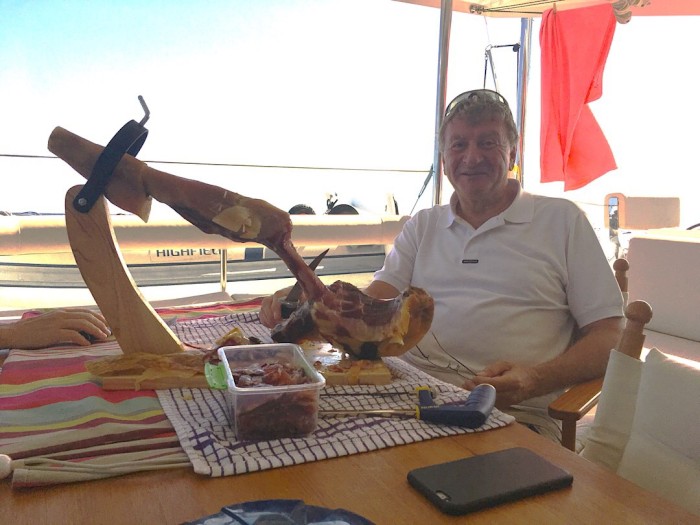
Yesterday saw the end of a well loved member of the Offbeat team. We decided that Napoleon, our Iberica ham, was getting towards the end of it's time with us. We've been carving slices off for lunch each day and recovering it with its original fat and cladding it in a tea towel to prevent it from drying out too much. We've been getting through the meat quite quickly and he was getting a little skinny and when, during the night, Napoleon leapt off his shelf and shed fat over the floor, we decided his time had come.
We've been doing very well with managing our rubbish, after over a week we have several bags of recycling waste in the bilge but are still on our first small bag of general waste which will also be held until St Lucia. To avoid rotting products on board, easily perishable organic food waste only can go in the sea but we have to dispose of any bone over 100 miles from the coast. Queue Mike with our filleting knife for a marathon carving session, after 90 minutes we had several Tupperware boxes of sliced ham and we then said goodbye over the side to our last souvenir of the Canaries.
As usual there was stuff to fix on board, our echo sounder had failed just before Cape Verde and the replacement is being couriered to meet us in St Lucia (thanks Amina!) but subsequently we were disturbed to lose two other instruments at starboard helm. Firstly one of our instrument displays went into a permanent reboot cycle, then eventually stopped completely, apparently dead, then one of the autopilot control pads adjacent to it also failed. Neither are particularly problematical, we have 2 other autopilot control pads and multiple means of seeing the data but it's inconvenient to lose the information at one of the two helm stations and was a bit worrying.. what might be next to go?
A series of emails back to JD, our every helpful marine electronics installer, suggested that it might be a power issue but after monitoring we saw this was fine. We were advised to disconnect the failed devices from the NMEA 2000 network, this is a marine version of the Ethernet standard. At this point we realised that both of the new failures were on the same side of the boat as the echosounder. Of course as soon as we'd disconnected this from the network both of the other instruments sprang back into life. Hooray...but I thought this sabbatical was about getting away from IT for a while!
We made really good time during the last 24 hours with our rebuilt downwind sail, chafe problems resolved and again our sailmakers are shipping a replacement cable with better thimbles to St Lucia (thanks Rob)!! We caught up over 20miles on the boats ahead but with Skyfall (the Lagoon 450) and Mango (Lagoon 50) still some way ahead. Both yachts had a head start on day 1 by motoring most the day whilst we sailed mostly, however both also have a different type of downwind sail called a Parasailor (google it). This Parasailor sail is proving very fast and difficult to beat however.
You may have noticed much of the fleet heading further south over the last two days, there are two reasons for this, firstly there was a patch of light wind forecast to the north which everyone wants to avoid and secondly the wind direction has steadily been swinging from an Easterly direction back towards the North East (the opposite to what might normally be expected in this part the ocean) this means boats heading directly downwind would sail in the gentle left hand turn you can see on the trackers as the wind shifts.
At 4am this morning, on the change of watch, we decided the time had come to drop our runner and change to our other furling code 0 sail. This would allow us to head back in the direction of St Lucia rather than Venezuela! Of course we were tired and it was windy and we made a right pigs ear of it, resulting in a massive tangle in the sail we were dropping. We should have waited until daylight. As of 1000 we're are romping along on our new course with the zero (please don't tell Skyfall!) and we hope that the Parasailor can't sail in this direction as easily! The tangled runner is sitting bundled in the bag in our cockpit waiting us to summon the mental energy to sort it out this afternoon....and people were asking me what we did all day on the boat!
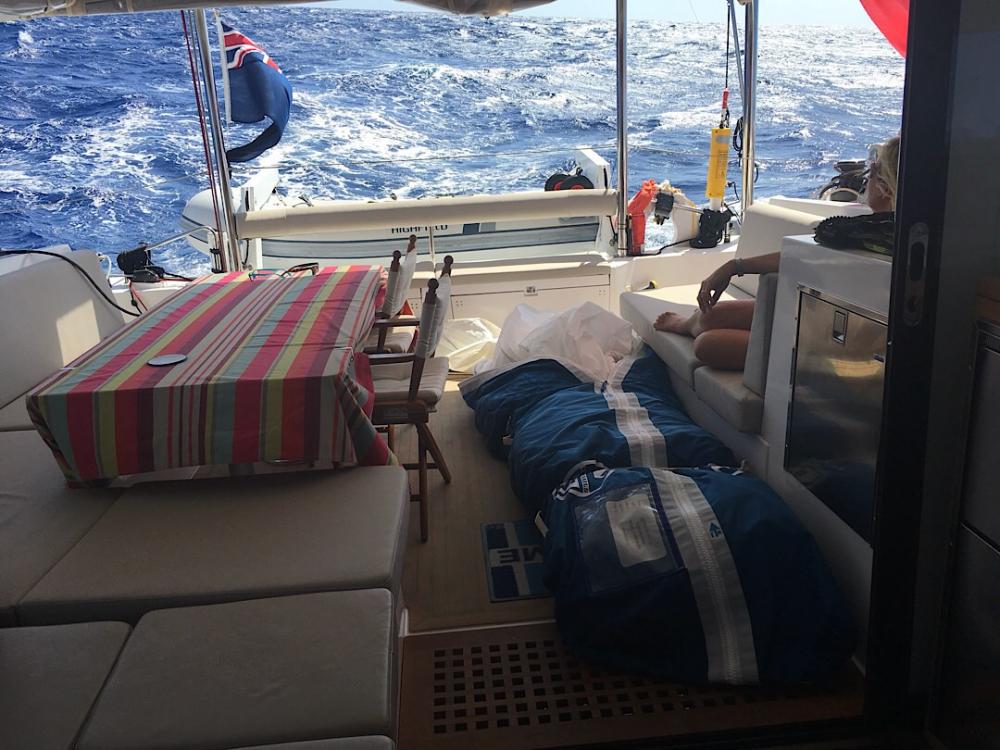
We've been doing very well with managing our rubbish, after over a week we have several bags of recycling waste in the bilge but are still on our first small bag of general waste which will also be held until St Lucia. To avoid rotting products on board, easily perishable organic food waste only can go in the sea but we have to dispose of any bone over 100 miles from the coast. Queue Mike with our filleting knife for a marathon carving session, after 90 minutes we had several Tupperware boxes of sliced ham and we then said goodbye over the side to our last souvenir of the Canaries.
As usual there was stuff to fix on board, our echo sounder had failed just before Cape Verde and the replacement is being couriered to meet us in St Lucia (thanks Amina!) but subsequently we were disturbed to lose two other instruments at starboard helm. Firstly one of our instrument displays went into a permanent reboot cycle, then eventually stopped completely, apparently dead, then one of the autopilot control pads adjacent to it also failed. Neither are particularly problematical, we have 2 other autopilot control pads and multiple means of seeing the data but it's inconvenient to lose the information at one of the two helm stations and was a bit worrying.. what might be next to go?
A series of emails back to JD, our every helpful marine electronics installer, suggested that it might be a power issue but after monitoring we saw this was fine. We were advised to disconnect the failed devices from the NMEA 2000 network, this is a marine version of the Ethernet standard. At this point we realised that both of the new failures were on the same side of the boat as the echosounder. Of course as soon as we'd disconnected this from the network both of the other instruments sprang back into life. Hooray...but I thought this sabbatical was about getting away from IT for a while!
We made really good time during the last 24 hours with our rebuilt downwind sail, chafe problems resolved and again our sailmakers are shipping a replacement cable with better thimbles to St Lucia (thanks Rob)!! We caught up over 20miles on the boats ahead but with Skyfall (the Lagoon 450) and Mango (Lagoon 50) still some way ahead. Both yachts had a head start on day 1 by motoring most the day whilst we sailed mostly, however both also have a different type of downwind sail called a Parasailor (google it). This Parasailor sail is proving very fast and difficult to beat however.
You may have noticed much of the fleet heading further south over the last two days, there are two reasons for this, firstly there was a patch of light wind forecast to the north which everyone wants to avoid and secondly the wind direction has steadily been swinging from an Easterly direction back towards the North East (the opposite to what might normally be expected in this part the ocean) this means boats heading directly downwind would sail in the gentle left hand turn you can see on the trackers as the wind shifts.
At 4am this morning, on the change of watch, we decided the time had come to drop our runner and change to our other furling code 0 sail. This would allow us to head back in the direction of St Lucia rather than Venezuela! Of course we were tired and it was windy and we made a right pigs ear of it, resulting in a massive tangle in the sail we were dropping. We should have waited until daylight. As of 1000 we're are romping along on our new course with the zero (please don't tell Skyfall!) and we hope that the Parasailor can't sail in this direction as easily! The tangled runner is sitting bundled in the bag in our cockpit waiting us to summon the mental energy to sort it out this afternoon....and people were asking me what we did all day on the boat!

A rather gentler Atlantic tonight...
26 November 2018
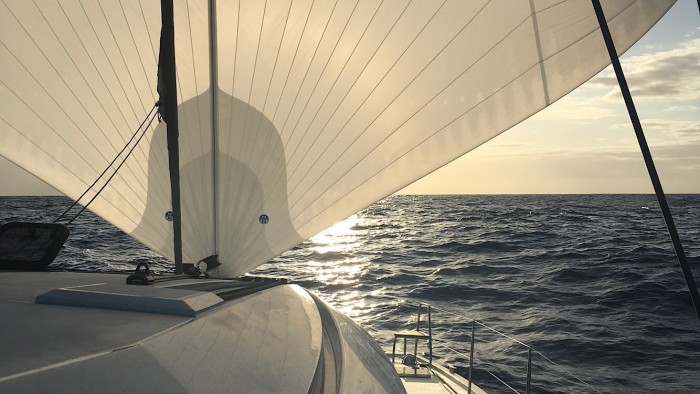
We've had a rather challenging couple of days and night; fairly big seas and lots of squalls at night necessitating numerous sail changes (which also normally means getting the whole crew out of bed) which, together with the constant noise in the cabins and movement as waves hit the boat, has resulted in disrupted sleep for most of us.
For the first time in over 2 years with Offbeat we even had to eat dinner inside on Saturday night as waves crashing into the side of the boat were drenching the cockpit table and seats with sea water. Fortunately yesterday the weather started to ease and the wind dropped below 25 kts for the first time since Thursday.
We tried reverting to our downwind sail, which had been so effective on the leg to Mindelo, unfortunately just before sunset we realised that yet again the chafe problem had recurred despite our supposedly robust repair. The answer was to use the sail folded in half which minimised the rolling motion. Unfortunately this means zigzagging downwind which means sailing a longer distance and also sometimes sailing the "wrong" direction as the wind shifts direction and it takes a lot of effort to gybe when the crew is asleep. The lashings on the sail survived the night, just, but this morning we took the sail down again and after 4 hours had effected another repair by drilling holes in the thimbles to which we could attach shackles to which we could lash the sail. As I write this at sunset we seem to have cracked the problem. The sailmakers have also been communicating with us on the issue and offered to ship a new cable out to St Lucia to address the problem. We appreciate the support after a frustrating time dealing with the problem.
The good news is that we are now sailing quickly and will do our best to catch up with some of the other boats we've been sailing with. Last night we reconnected with some of the fleet, although because we were zigzagging this meant we were a bit of a pain for some of them. The first boat we came across was Porto Salgado, this is a Portuguese registered yacht but is in fact crewed by a happy group of Irishmen whom Mike and I had closed the bar with in Mindelo.
As our courses converged around midnight we could see that we were on collision course. Each boat carries an “AIS” transponder which broadcasts its position, speed and course; this means nearby boats and ships appear as icons on our chart-plotters. There are "Collision Regulations" or ColRegs determining which boat should change course to avoid the other, they were the "give way vessel". In this case it was their obligation to alter course to miss us. We called Conor's crew on the radio, VHF channel 72 ( all ARC boats are listening to this, as well as the normal channel 16). They agreed that they'd alter course and we'd keep going. 15 minutes later they passed astern and after a further call we agreed we owed them a drink in St Lucia. 3 hours later we'd gybed back and came across them again. This time is was our turn to avoid them, which we did. So now we've got 2 rounds of drinks scheduled for the arrival!
We also emailed our friends Patrik and Birgitta on their Lagoon 50, Mango, we'd noticed that after a quick start they'd appeared to drop back. It turned out that their tracker hadn't been updating, they were fine and in fact were dining on a 20kg Mahi-Mahi they'd caught that day. After a further round of emails the fish had shrunk to 10kg but still an enviable result. We haven't caught anything yet so our fresh protein stocks are getting limited!
The gentler last 24 hours means that we've also had time and the energy to sort lots of other little issues. We've fixed a problem with a sump pump for the showers on the guest hull (clogged float switch), we've done three loads of washing (yes, we have a washing machine on board), we have full tanks of fresh water so we've all had at least one shower today (it was very warm earlier) and were also able to hose down the cockpit seats, table, deck and sailbags with fresh water.
We've also been eating well on board and the baking has continued. The latest delicacy being Sarah's banana bread, complementing Lucy's regular bread and the slices of Napoleon's leg (as our large Iberico ham has been named) carved carefully by Mike, demonstrating the dexterity that befits a long career as a dentist. As the winds were light tonight we also treated ourselves to a glass of Crianza Riserva.
I'll leave you with a photo taken just as we sat down to eat tonight. It's just got dark, we are romping along 7.6kts speed in 14knots of wind and with only 1250 miles to go we should pass the halfway point across the Atlantic tomorrow. Goodnight all!
For the first time in over 2 years with Offbeat we even had to eat dinner inside on Saturday night as waves crashing into the side of the boat were drenching the cockpit table and seats with sea water. Fortunately yesterday the weather started to ease and the wind dropped below 25 kts for the first time since Thursday.
We tried reverting to our downwind sail, which had been so effective on the leg to Mindelo, unfortunately just before sunset we realised that yet again the chafe problem had recurred despite our supposedly robust repair. The answer was to use the sail folded in half which minimised the rolling motion. Unfortunately this means zigzagging downwind which means sailing a longer distance and also sometimes sailing the "wrong" direction as the wind shifts direction and it takes a lot of effort to gybe when the crew is asleep. The lashings on the sail survived the night, just, but this morning we took the sail down again and after 4 hours had effected another repair by drilling holes in the thimbles to which we could attach shackles to which we could lash the sail. As I write this at sunset we seem to have cracked the problem. The sailmakers have also been communicating with us on the issue and offered to ship a new cable out to St Lucia to address the problem. We appreciate the support after a frustrating time dealing with the problem.
The good news is that we are now sailing quickly and will do our best to catch up with some of the other boats we've been sailing with. Last night we reconnected with some of the fleet, although because we were zigzagging this meant we were a bit of a pain for some of them. The first boat we came across was Porto Salgado, this is a Portuguese registered yacht but is in fact crewed by a happy group of Irishmen whom Mike and I had closed the bar with in Mindelo.
As our courses converged around midnight we could see that we were on collision course. Each boat carries an “AIS” transponder which broadcasts its position, speed and course; this means nearby boats and ships appear as icons on our chart-plotters. There are "Collision Regulations" or ColRegs determining which boat should change course to avoid the other, they were the "give way vessel". In this case it was their obligation to alter course to miss us. We called Conor's crew on the radio, VHF channel 72 ( all ARC boats are listening to this, as well as the normal channel 16). They agreed that they'd alter course and we'd keep going. 15 minutes later they passed astern and after a further call we agreed we owed them a drink in St Lucia. 3 hours later we'd gybed back and came across them again. This time is was our turn to avoid them, which we did. So now we've got 2 rounds of drinks scheduled for the arrival!
We also emailed our friends Patrik and Birgitta on their Lagoon 50, Mango, we'd noticed that after a quick start they'd appeared to drop back. It turned out that their tracker hadn't been updating, they were fine and in fact were dining on a 20kg Mahi-Mahi they'd caught that day. After a further round of emails the fish had shrunk to 10kg but still an enviable result. We haven't caught anything yet so our fresh protein stocks are getting limited!
The gentler last 24 hours means that we've also had time and the energy to sort lots of other little issues. We've fixed a problem with a sump pump for the showers on the guest hull (clogged float switch), we've done three loads of washing (yes, we have a washing machine on board), we have full tanks of fresh water so we've all had at least one shower today (it was very warm earlier) and were also able to hose down the cockpit seats, table, deck and sailbags with fresh water.
We've also been eating well on board and the baking has continued. The latest delicacy being Sarah's banana bread, complementing Lucy's regular bread and the slices of Napoleon's leg (as our large Iberico ham has been named) carved carefully by Mike, demonstrating the dexterity that befits a long career as a dentist. As the winds were light tonight we also treated ourselves to a glass of Crianza Riserva.
I'll leave you with a photo taken just as we sat down to eat tonight. It's just got dark, we are romping along 7.6kts speed in 14knots of wind and with only 1250 miles to go we should pass the halfway point across the Atlantic tomorrow. Goodnight all!
Cape Verde and onwards
23 November 2018
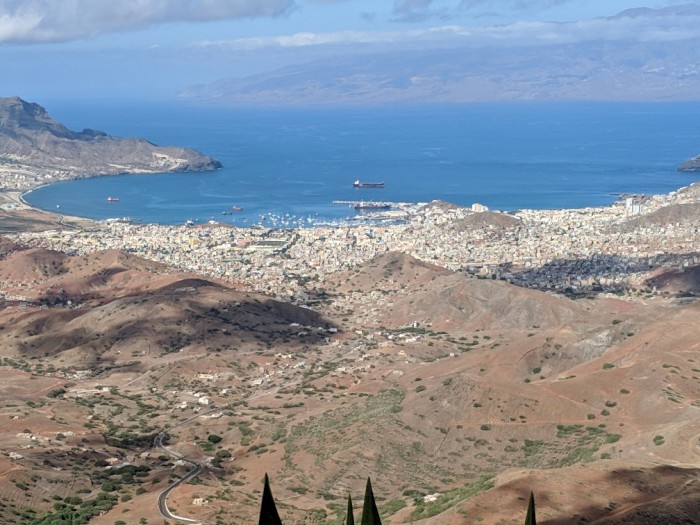
We spent the early part of the week in Mindelo, the major town on Sao Vincente, one of the inhabited islands of the Cape Verdes. Whilst it's not the capital it does have a wonderful natural harbour, formed by the collapsed rim of a volcanic crater. It was a strategic port leased by the British as a bunkering centre, holding imported coal to refuel ships plying the African coast before the switch to oil. It also has a modern marina which can cater for several hundred yachts; the port manager also does basic sail repairs and helpfully repaired the mainsail stack pack which we had torn whilst reefing then sail on the passage down from Las Palmas and there is a tiny chandlery (aka the sweetie shop as we can't ever pass one without popping in to buy something). Mindelo is therefore the obvious stop for yachts crossing the Atlantic, unless going direct from the Canaries (as the main ARC fleet will do in a week or so).
Apart from the port and marina we came to the conclusion that the Sao Vincente wouldn't be top of the list of places to visit again. It's a barren place; volcanic and no surface water, the island is poor but not poverty stricken. The island has an airport and is trying to develop a tourist industry as a cheap winter sun destination. It's certainly hot in November!
On Monday we took a half day tour of the island but minibus with other ARC+ competitors. There is a great camaraderie developing amongst the fleet and several boats we are getting to know very well... LaDiala, Mango, Rokhea, Lallona, La Boheme, Malisa, The Project and many others. We stopped at the highest peak on the island with spectacular views of the bay, visited some amazing dunes with white sand carried across the ocean from the Sahara and crossed miles of bleak country side with interesting attempts as commerce ( a massive shrimp farm under development, a failed water entertainment park etc.), we also saw a few fishing villages, catching fish in traditional ways from small sailing dhows.
On Tuesday we also visited a local charity which rescues boys from the streets. There is a lot of begging in the town, which we'd been warned about on arrival, many young lads are on the streets and suffering from drug and alcohol addition, the charity provides a recovery centre with some success, although many boys "escape". It was shocking to hear how many of the boys had been abandoned by their families, often children of teenage mums.
Wednesday was departure day, we completed the checkout formalities and we amongst the first to leave the dock a couple of hours before the start. We anchored in the bay, swam and took the opportunity to make fresh water from our watermaker to replace the water from the dock which we were unsure about drinking despite adding purifying chemicals. We decided to keep one tank of dock water for washing and showers which we replaced with watermaker water after a day at sea, but had a whole tank of watermaker water before we set off.
The start and first day were challenging, we really wanted to do the leg without motoring, but the weather conspired against us with only 4 to 7 knots at the start. The majority of the fleet charged off under motor within minutes of the start. We sailed for a couple of hours then took what has become known as the "flyer", we headed south in the light breeze, partially avoiding the large wind hole by the neighbouring island, whilst the majority of the fleet motored due west. This left us some 30 miles behind the fleet in terms of the direct route to the finish, which you will see on the tracker, but we think we have motored considerably less than that leading group which should get addressed on the handicap later. It has to be said there is a view on board that my decision to sail south was a cock-up! It's done now, so time will tell, but we have been the quickest multihull over the last few checkpoints.
The last 24 hours have been somewhat demanding as the wind built: Thursday afternoon saw us screaming along with the furling code 0 but as night fell we ended up have to reduce sail three times ( furled the zero then put reefs one then two into the mainsail) all between midnight and 3am. For any work on the foredeck we get the whole crew out of bed. Reefing the main is easier as we can do this from the cockpit but we always have three up for this to handle the lines.
Yesterday was a bit of a sleigh ride, high speeds up to 13 kts surfing down the large waves as the wind held between 25 kts and 30 kts all day. We are out of sight of the rest of the fleet but passed a lone French yacht "Nomade" late in the afternoon and had a chat on the VHF radio, they are heading for Martinique, one of the many yachts crossing the Atlantic on their own.
It's now 0200 on Saturday, we put the third reef in the main a few hours ago as the breeze was back at 30 kts and there were lots of squalls visible on the radar, so now have a very small amount of sail up. This is giving everyone a chance to catch up on sleep and the wind has moderated slightly. We'll probably put more sail up in the morning. We are expecting the wind to stay strong for another 36 hours but then ease to a gentler 15-20 knots.
Keep posting the comments and sending the emails we are enjoying your views on our progress!!
Apart from the port and marina we came to the conclusion that the Sao Vincente wouldn't be top of the list of places to visit again. It's a barren place; volcanic and no surface water, the island is poor but not poverty stricken. The island has an airport and is trying to develop a tourist industry as a cheap winter sun destination. It's certainly hot in November!
On Monday we took a half day tour of the island but minibus with other ARC+ competitors. There is a great camaraderie developing amongst the fleet and several boats we are getting to know very well... LaDiala, Mango, Rokhea, Lallona, La Boheme, Malisa, The Project and many others. We stopped at the highest peak on the island with spectacular views of the bay, visited some amazing dunes with white sand carried across the ocean from the Sahara and crossed miles of bleak country side with interesting attempts as commerce ( a massive shrimp farm under development, a failed water entertainment park etc.), we also saw a few fishing villages, catching fish in traditional ways from small sailing dhows.
On Tuesday we also visited a local charity which rescues boys from the streets. There is a lot of begging in the town, which we'd been warned about on arrival, many young lads are on the streets and suffering from drug and alcohol addition, the charity provides a recovery centre with some success, although many boys "escape". It was shocking to hear how many of the boys had been abandoned by their families, often children of teenage mums.
Wednesday was departure day, we completed the checkout formalities and we amongst the first to leave the dock a couple of hours before the start. We anchored in the bay, swam and took the opportunity to make fresh water from our watermaker to replace the water from the dock which we were unsure about drinking despite adding purifying chemicals. We decided to keep one tank of dock water for washing and showers which we replaced with watermaker water after a day at sea, but had a whole tank of watermaker water before we set off.
The start and first day were challenging, we really wanted to do the leg without motoring, but the weather conspired against us with only 4 to 7 knots at the start. The majority of the fleet charged off under motor within minutes of the start. We sailed for a couple of hours then took what has become known as the "flyer", we headed south in the light breeze, partially avoiding the large wind hole by the neighbouring island, whilst the majority of the fleet motored due west. This left us some 30 miles behind the fleet in terms of the direct route to the finish, which you will see on the tracker, but we think we have motored considerably less than that leading group which should get addressed on the handicap later. It has to be said there is a view on board that my decision to sail south was a cock-up! It's done now, so time will tell, but we have been the quickest multihull over the last few checkpoints.
The last 24 hours have been somewhat demanding as the wind built: Thursday afternoon saw us screaming along with the furling code 0 but as night fell we ended up have to reduce sail three times ( furled the zero then put reefs one then two into the mainsail) all between midnight and 3am. For any work on the foredeck we get the whole crew out of bed. Reefing the main is easier as we can do this from the cockpit but we always have three up for this to handle the lines.
Yesterday was a bit of a sleigh ride, high speeds up to 13 kts surfing down the large waves as the wind held between 25 kts and 30 kts all day. We are out of sight of the rest of the fleet but passed a lone French yacht "Nomade" late in the afternoon and had a chat on the VHF radio, they are heading for Martinique, one of the many yachts crossing the Atlantic on their own.
It's now 0200 on Saturday, we put the third reef in the main a few hours ago as the breeze was back at 30 kts and there were lots of squalls visible on the radar, so now have a very small amount of sail up. This is giving everyone a chance to catch up on sleep and the wind has moderated slightly. We'll probably put more sail up in the morning. We are expecting the wind to stay strong for another 36 hours but then ease to a gentler 15-20 knots.
Keep posting the comments and sending the emails we are enjoying your views on our progress!!
It's a ra..ra..rally but the results are ...
20 November 2018
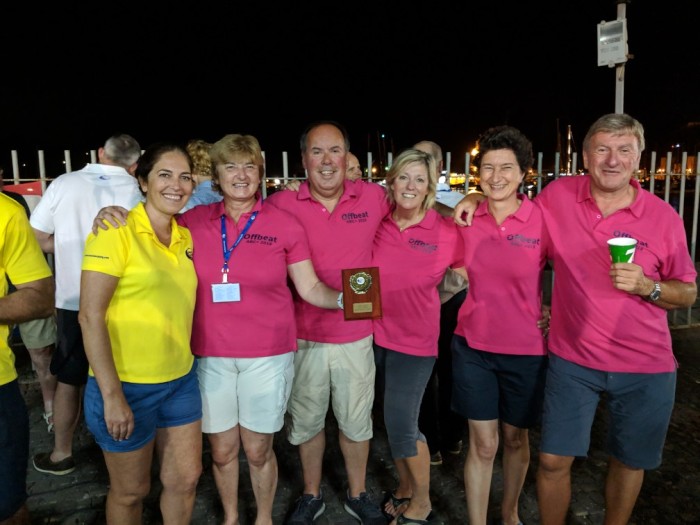
We finally arrived in Mindelo at midday on Saturday. The last 48 hours at sea were very easy; flat seas and light winds and no more squalls. We mostly flew our downwind sail and steadily edged away from Skyfall (a similar sized catamaran, Lagoon 450F) with whom we'd been in close company for much of the leg.
Just before dawn Mike and Sarah saw the lights of the Cape Verde islands and as the sun came up we could clearly see the jagged volcanic peaks of the archipelago some 30 miles away. Over the final few hours we saw more and more ARC+ boats as the fleet converged on the finish at Mindelo. We crossed the finish line, between a headland and an off-lying rock, at 1203 UTC; 5 days and 22 hours sailing for just under 900 miles. I've always been exhausted after a long trip but plenty of sleep in the calm conditions and lots of water for showers meant that we arrived fresh.
The marina organisation was super efficient so we were soon berthed stern to on a long emply pontoon which had been cleared for the fleet. We were soon ensconced in the floating bar at the end of the dock downing a cold beer and comparing notes with the other early finishers.
As always there was work to be done on the boat but mostly minor for us. The pontoons were soon filled with sails; nearly everyone has had some repairs to make with their spinnakers or halliards.
Our echosounder had failed to come back to life when we reached the coast (it can't pick up the depth in 4000m of water but should do when we are back under 100m), testing showed that the unit had failed. It's not much of a safety issue for now. Within 5 minutes of leaving the dock we will be in over 200 metres of water and it will stay that way until St Lucia. We also have a second forward scanning sonar in the other hull which provides depth readings and is working, we will display this data on our instruments.
We checked our temporary lashings we had made during the first night on the downwind sail and discovered there was more chafe, this time surprisingly from inside the lashings. We spent two hours taking both head and tack apart and discovered that the thimbles (metal eyes) at each end of the furling cable had very sharp edges under the lashing (not really fit to be used on a sail like this). We've reinforced the protection both under and over the lashings and are now fairly confident they should last the Atlantic crossing.
Finally we hoisted Lucy up the mast again to check the rig and also shortened the spinnaker halliard by 50cm to move the wear points slightly. No issues found and we are ready for the next leg.
Over the weekend the boats continued to arrive, many having to motor in order to arrive by the deadline of 1730 on Sunday. Last night we had the prizegiving a local hall., another great party and chance to catch up with many of the new friends we have been making on other boats.
Each boat's potential speed is assessed before the event, a speed rating is calculated by the organisers based on factors such as the dimensions of the boat, the sail area and type of sails carried and the weight. This time correction factor or TCF is used to adjust each boat's time to allow fair performance to be measured between the fleet. In normal yacht racing we have to sail the whole time, on this rally you can use your motor but at the finish the skippers then declare to the organisers how long they were used for and the speed when motoring, a penalty time is then applied for the time and distance covered under motor. This is why the leaderboards you will be seeing on the tracker doesn't tell the whole story on the competition. Lifeaholic who led most of the way, was actually motoring for over 100 hours (most of the way) and finished right at the back of the fleet on corrected time.
We knew that we would have to finish between 2 and 12 hours ahead of the other multihulls to beat them on corrected time as we were rated as the second fastest boat in the fleet behind the large trimaran Tri2Fly. The German team on Skyfall rate slightly slower and finished 90 minutes behind us. We knew they'd motored more than us but not how much so we knew that the result would be close. The results were announced ... Crean third place, Skyfall second and a very delighted Offbeat crew first, 2.5 hours ahead on corrected time!
Unfortunately we can't remember much of the rest of the night...the rum punches were rather strong!! The Skyfall crew have been diving under their boat to clean the bottom and challenge issued for the next leg....it's clear that they are ra...ra..racing!
Just before dawn Mike and Sarah saw the lights of the Cape Verde islands and as the sun came up we could clearly see the jagged volcanic peaks of the archipelago some 30 miles away. Over the final few hours we saw more and more ARC+ boats as the fleet converged on the finish at Mindelo. We crossed the finish line, between a headland and an off-lying rock, at 1203 UTC; 5 days and 22 hours sailing for just under 900 miles. I've always been exhausted after a long trip but plenty of sleep in the calm conditions and lots of water for showers meant that we arrived fresh.
The marina organisation was super efficient so we were soon berthed stern to on a long emply pontoon which had been cleared for the fleet. We were soon ensconced in the floating bar at the end of the dock downing a cold beer and comparing notes with the other early finishers.
As always there was work to be done on the boat but mostly minor for us. The pontoons were soon filled with sails; nearly everyone has had some repairs to make with their spinnakers or halliards.
Our echosounder had failed to come back to life when we reached the coast (it can't pick up the depth in 4000m of water but should do when we are back under 100m), testing showed that the unit had failed. It's not much of a safety issue for now. Within 5 minutes of leaving the dock we will be in over 200 metres of water and it will stay that way until St Lucia. We also have a second forward scanning sonar in the other hull which provides depth readings and is working, we will display this data on our instruments.
We checked our temporary lashings we had made during the first night on the downwind sail and discovered there was more chafe, this time surprisingly from inside the lashings. We spent two hours taking both head and tack apart and discovered that the thimbles (metal eyes) at each end of the furling cable had very sharp edges under the lashing (not really fit to be used on a sail like this). We've reinforced the protection both under and over the lashings and are now fairly confident they should last the Atlantic crossing.
Finally we hoisted Lucy up the mast again to check the rig and also shortened the spinnaker halliard by 50cm to move the wear points slightly. No issues found and we are ready for the next leg.
Over the weekend the boats continued to arrive, many having to motor in order to arrive by the deadline of 1730 on Sunday. Last night we had the prizegiving a local hall., another great party and chance to catch up with many of the new friends we have been making on other boats.
Each boat's potential speed is assessed before the event, a speed rating is calculated by the organisers based on factors such as the dimensions of the boat, the sail area and type of sails carried and the weight. This time correction factor or TCF is used to adjust each boat's time to allow fair performance to be measured between the fleet. In normal yacht racing we have to sail the whole time, on this rally you can use your motor but at the finish the skippers then declare to the organisers how long they were used for and the speed when motoring, a penalty time is then applied for the time and distance covered under motor. This is why the leaderboards you will be seeing on the tracker doesn't tell the whole story on the competition. Lifeaholic who led most of the way, was actually motoring for over 100 hours (most of the way) and finished right at the back of the fleet on corrected time.
We knew that we would have to finish between 2 and 12 hours ahead of the other multihulls to beat them on corrected time as we were rated as the second fastest boat in the fleet behind the large trimaran Tri2Fly. The German team on Skyfall rate slightly slower and finished 90 minutes behind us. We knew they'd motored more than us but not how much so we knew that the result would be close. The results were announced ... Crean third place, Skyfall second and a very delighted Offbeat crew first, 2.5 hours ahead on corrected time!
Unfortunately we can't remember much of the rest of the night...the rum punches were rather strong!! The Skyfall crew have been diving under their boat to clean the bottom and challenge issued for the next leg....it's clear that they are ra...ra..racing!
Lines out all day...result two fish!
15 November 2018
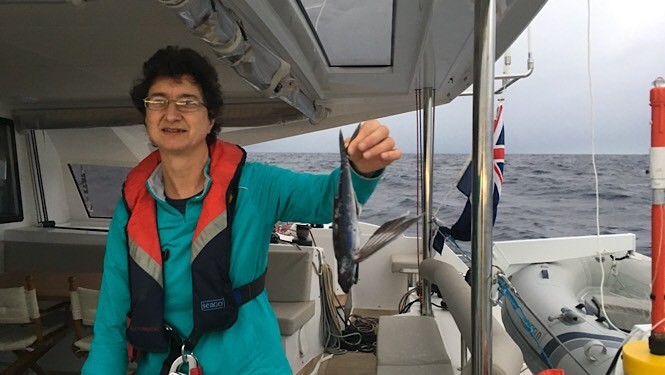
Sunrise yesterday saw a beautiful blue sky and 12-14 kts of wind. We’d overnight sailed on reefed main and jib so decided to try our spinnaker again. Of course the wind immediately increased to 18kts plus, very rapid sailing on a Nautitech Open 46; we set a new all-time boat speed record 16.7kts surfing down a large wave but after an hour decided that hand steering all day would get in the way of our relaxing cruise. We reverted to our downwind sail. Plenty of exercise before 1000 on a Wednesday morning.
We then decided to take up the most English of pastimes...fishing. We had the line out all day and as I write this at 0745 Thursday morning I can report that we’ve caught two fish. Any other ARC+ boats have more??? Please note in comments below..
Only trouble is that neither were Tuna, just two flying fish who leapt into our cockpit!
We’ve noticed lots of different rig choices between the boats out here in the rather squally conditions. We’ve been sailing for the last 24 hours in close company with Skyfall (parasailor), Thilde (main and poled out jib), whilst we’ve been mostly using our runner. I think we were all a bit surprised to see Lifeaholic shoot by us at sunset apparently under bare poles :-)
We then decided to take up the most English of pastimes...fishing. We had the line out all day and as I write this at 0745 Thursday morning I can report that we’ve caught two fish. Any other ARC+ boats have more??? Please note in comments below..
Only trouble is that neither were Tuna, just two flying fish who leapt into our cockpit!
We’ve noticed lots of different rig choices between the boats out here in the rather squally conditions. We’ve been sailing for the last 24 hours in close company with Skyfall (parasailor), Thilde (main and poled out jib), whilst we’ve been mostly using our runner. I think we were all a bit surprised to see Lifeaholic shoot by us at sunset apparently under bare poles :-)
| Vessel Name: | Offbeat |
| Vessel Make/Model: | Nautitech Open 46 (2016-2018) |
| Hailing Port: | See www.sailingoffbeat.com for the new boat and our latest adventures. |
| Crew: | David, Anne-Laure, Lucy, Mike and Sarah |
| About: | See www.sailingoffbeat.com for the new boat and our latest adventures. |
| Extra: | Offbeat was a Nautitech Open 46 sailing catamaran which took part in the 2018 ARC+Cape Verde crewed by David, Anne-Laure, Lucy, Mike and Sarah. |
| Social: |
Sailing Offbeat
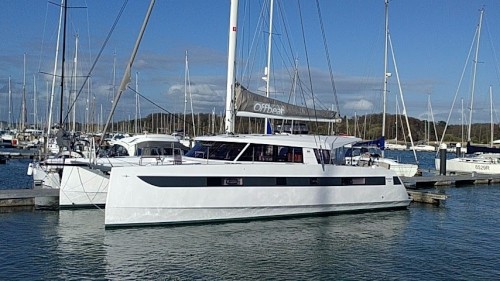
Who: David, Anne-Laure, Lucy, Mike and Sarah
Port: See www.sailingoffbeat.com for the new boat and our latest adventures.








